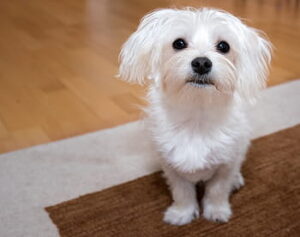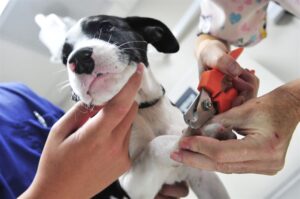You may be concerned as to how to successfully socialize your new puppy during social isolation protocols. We are here to help you and your puppy navigate this stressful time. Though our exposure to some stimuli is now limited, there’s so much we can do. Here are some tips on how to continue socialization during containment:
Using Audio and Video Stimuli
There are many videos on the internet that replicate the same sounds that your puppy may experience outside. Examples include construction noise, traffic, skateboard sounds, and sounds of kids playing. Our goal is to expose our pups to these noises so that they are no big deal. Start off by playing these sounds at a level that is barely audible, and day by day if your pup shows no reaction to the sounds, increase the volume. The key here is to watch your puppy’s body language. Your pup’s signals of unease can be subtle and easy to miss. While you’re looking for a loose, wiggly, and enthusiastic puppy, if you’re unsure we can help you identify signs of stress. During the socialization window, exposure isn’t what matters – it’s your pup’s emotional reaction to new things that matters.
Weird movement? No Problem
On top of strange noises, we can expect that pups will have to tolerate all kinds of stimuli coming towards them unexpectedly over the course of their lives. While you can’t bike or skateboard through your apartment, you do have a broom, a blow dryer, and a vacuum. After your pup shows no reaction to the sounds of these items, you can start working on desensitizing them to movement. Remember to start at a low level and to work your way up. It is better to go slow here than to move too fast and risk your pup developing a negative reaction.
Tolerance to Sudden Environmental Change (SEC)
We want to be sure your puppy is comfortable with changes in their environment. Now that the environment is somewhat constricted, we have to be creative in making sure your puppy is exposed to changes so he or she will not be overwhelmed when changes happen in real life. Move items in your house when your puppy isn’t looking. Use what you have around the house to create obstacle courses. We then encourage your puppy to explore this “new” environment while ensuring the process is fun! Together, we can find ways to disrupt your environment so that change is a normal part of your puppy’s life.
All Surfaces Are Safe

We want to be sure your puppy is exposed to a variety of walking surfaces to prevent phobias from developing to different floor substrates. We can do this at home by setting up an “obstacle course” that includes things like stairs and mimics different surfaces your puppy will encounter out in the world. Your pup should feel comfortable walking on carpet, wood, tile, linoleum, cement, and grates.
From Ears to Tails, Eyes to Nails

We want to be sure your puppy is comfortable with all kinds of touch, from being picked up to having their nails clipped. We can practice this at home through conditioning and desensitization. We have plenty of time – and now is the time to ensure our pups are totally comfortable with being pet, having their paws held, ears swabbed, eyes opened, teeth checked, and feeling gentle pokes with the eraser end of a pencil (to mimic injections).
Here at Behavior Vets we are offering virtual class: Puppy Socialization 911
For puppies up to 16 weeks of age: You can start at any time! Sign up here!
At The End Of Class, Your Puppy Will:
- Ask politely when they need something from you
- Explore the world with confidence
- Settle calmly in many environments, including when confined, when alone, and when lots of new stuff is happening around them
- Potty where they’re supposed to, when they’re supposed to
- Chew on toys, not fingers
- Walk calmly by your side, ignoring distractions
Please contact us today at nyc@behaviorvets.com or call us at 646-661-1001. We look forward to seeing you online!

